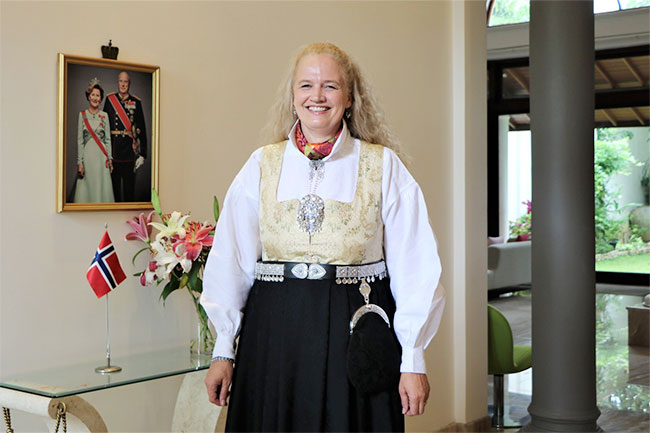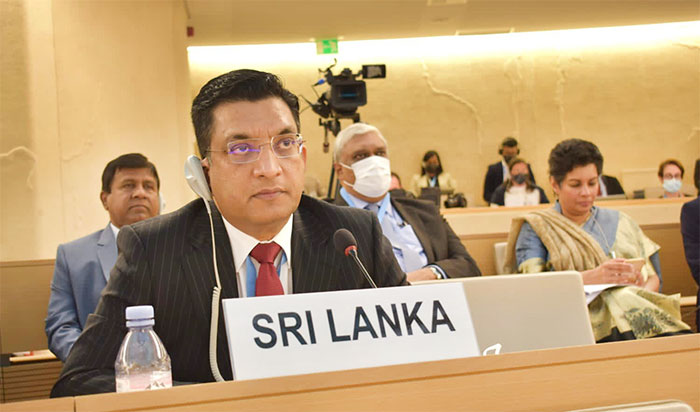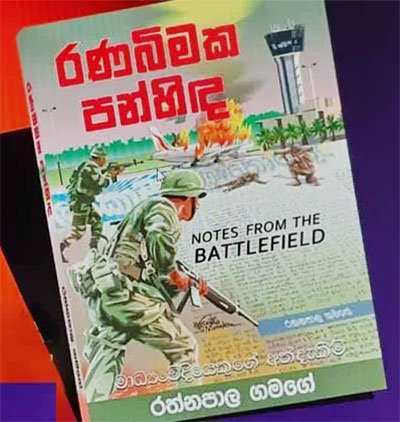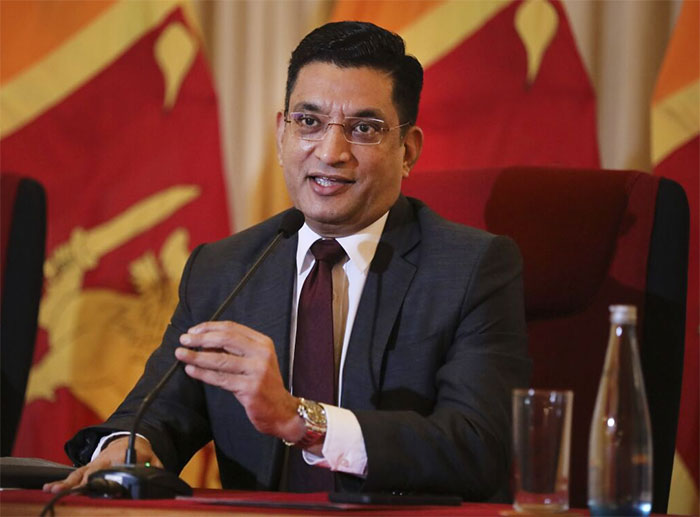SPECIAL REPORT : Part 437
” Norway will never forget how LTTE influenced the worst ever act of terrorism on its soil. Far right Norwegian Andres Breivik, 32, responsible for the July 22, 2011 massacre of 77 persons, mostly teenagers in two successive attacks in Norway was inspired by the LTTE. A few hours before, Breivik went on the rampage, he made reference to the LTTE’s eviction of the Muslim community from the Northern Province in Oct/Nov 1990, in his so-called manifesto released online. The following are the references (1) Pro-Sri Lanka (supports the deportation of all Muslims from Sri Lanka) (Page 1235) and (2) Fourth Generation War is normally characterized by a ‘stateless’ entity fighting a state or regime (the EUSSR). Fighting can be physically such as the Liberation Tigers of Tamil Eelam (LTTE) to use a modern example. (Page 1479). Perhaps, Sri Lanka should ask for an international inquiry. One of Sri Lanka’s foremost diplomats Jayantha Dhanapala appearing before the Lessons Learnt and Reconciliation Commission (LLRC) in 2010 stressed the accountability on the part of foreign governments. The then Mahinda Rajapaksa government probably blinded by unfathomable victory was not bothered. It only sought political advantage of the developments even at the expense of Sri Lanka.”
By Shamindra Ferdinando
Norway on Sept 09 announced that its diplomatic mission in Colombo will be closed at the end of July 2023. The Norwegian Embassy in Colombo declared that this would be among five diplomatic missions to be closed as part of the planned structural reforms in its network of diplomatic missions. The Embassy didn’t mention the other diplomatic missions facing closure.
Norway established a diplomatic mission here in 1996 during Chandrika Bandaranaike Kumaratunga’s presidency. The setting up of that mission was primarily to facilitate negotiations between Sri Lanka and the Liberation Tigers of Tamil Eelam (LTTE). The establishment of the Colombo mission took place in the wake of the military consolidating its position in the Jaffna peninsula. Jaffna town was brought under government control in early Dec 1995.
The signing of the one-sided Ceasefire Agreement (CFA) in Feb 2002 can be considered the highpoint of the Norwegian intervention here that allowed the LTTE to expand its sphere of influence. Who really drafted the CFA? Did the then top Norwegian negotiator Erik Solheim draft it as he claimed in an interview with the late Kumar Rupesinghe? Whatever the circumstances, the CFA certainly didn’t take into consideration concerns of the military.
However, the Norwegian Embassy made available the Norwegian Foreign Ministry press release that dealt with the proposed closure of some diplomatic missions. Accordingly, the diplomatic missions in Slovakia, Kosovo and Sri Lanka and the Embassy office in Madagascar and the Consulate General in Houston, Texas, are to be closed. It would be pertinent to mention that Norway established a diplomatic mission in Slovakia in Sept. 2004, just a year after Slovakia moved out of the Czechoslovakian Federation and in Kosovo four years later. NATO member Norway participated in large scale air offensive to drive out Serbian forces from Kosovo-Norway set up Embassy office in Madagascar in 2004 and the Houston ‘mission’ back in 1977.
The closure of the Norwegian Embassy in Colombo should be also examined against the backdrop of cash- strapped Sri Lanka closing down our missions in Norway and Iraq and the Consulate General in Sydney, Australia, early this year.
Norway has thrown its weight behind a new six-page draft resolution before the Geneva-based United Nations Human Rights Council, (UNHRC) handed in by the UK. The UK leads Sri Lanka Core Chairs and the resolution is widely regarded as the strongest since the successful conclusion of the war against the LTTE in May 2009.
A vote on this new resolution is due before the sessions end on October 7. Sessions commenced on Sept 12.
The resolution is co-sponsored by the United States, Canada, Germany, Malawi, Montenegro, and North Macedonia. Sri Lanka’s rejection of the latest resolution is irrelevant. Therefore, another heavy defeat at the UNHRC is quite possible. But, Sri Lanka conveniently failed so far to set the record straight in Geneva and at the United Nations General Assembly in New York. Successive governments allowed Geneva to dictate terms by failing to present Sri Lanka’s case. The incumbent government is no exception.
Oslo has announced the termination of its mission here over a decade after the eradication of the LTTE’s conventional military capability. Had the Western sinister project succeeded, Sri Lanka would have been divided on ethnic lines. The CFA allowed the LTTE freedom to operate in the Northern and Eastern Province as it did away with restrictions placed on Tiger armed cadres entering government-held areas. The Norwegian led Sri Lanka Monitoring Mission (SLMM) that was empowered to oversee the Ceasefire Agreement, continued to mollycoddle the LTTE in spite of a spate of blatant CFA violations by the Tigers.
In the wake of the then treacherous UNP government exposing the covert intelligence operation carried out by the Directorate of Military Intelligence (DMI) behind enemy lines, the LTTE went after its operatives with a vengeance. The Norwegians went to the extent of providing funding to the LTTE and its front organizations, much to the dismay of those who really believed in a genuine effort to bring peace.
The Norwegian funding continued even after the LTTE quit the negotiating table in late April 2003. There had never been a proper examination of the Norwegian intervention here though Norway funded the costly joint study undertaken by Gunnar Sorbo of the Chr. Michelsens Institute (CMI) and Jonathan Goodhand of the School of Oriental and African Studies (SOAS). Their report titled Pawns of Peace: Evaluation of Norwegian peace efforts in Sri Lanka 1997-2009, released in September 2011 made specific reference to the SLMM, having accessibility to best possible intelligence.
High profile Oslo project
According to the report, the SLMM received intelligence from both the North Atlantic Treaty Organization (NATO) and India’s premier intelligence agency, the Research and Analysis Wing (RAW).
Thanks to NATO and India, those running the peace process couldn’t have been unaware of the LTTE’s rapid preparations for war. Norway received NATO support as a member of the military alliance (Pawns of Peace: Evaluation of Norwegian peace efforts in Sri Lanka 1997-2009, page 100).
The Norwegian study quoted the then SLMM head as having said that RAW only reached them through informal channels, therefore they couldn’t be fully trusted. “They weren’t giving it to us to be nice. We would always ask ourselves why they want us to know this. Intelligence provided by NATO only confirmed what they already knew”, the SLMM chief was quoted as having said.
The RAW destabilized Sri Lanka to such an extent, beginning with the election of J.R. Jayewardene, because of his overt tilt to the West, Sri Lanka was compelled to transform its ceremonial army into a lethal fighting force.
But, those who had been pursuing hostile agenda against us in Geneva quite conveniently forget how major powers ruined Sri Lanka by sponsoring, particularly the LTTE terrorism, and also giving them a free hand. Can the so-called leader of the Core Group, the UK, absolve itself of the responsibility for promoting terrorism here? The UK allowed LTTE’s International Secretariat to propagate the war against a Commonwealth country from London, granted citizenship to the late Anton Balasingham who advised Prabhakaran on terror project and even allowed secret talks therein between the LTTE theoretician and top Norwegian diplomats in the wake of the then Foreign Minister Lakshman Kadirgamar’s assassination by the Tigers. The UK has also given refuge to his wife Adele despite her having nourished Tamil young girls to take up violence. She was photographed donning cyanide capsules around the necks of such girls as they passed out after training.
The LTTE assassinated Kadirgamar on Aug 12, 2005, while the CFA, supervised by Scandinavian countries, was in operation. On April 25, 2006, the LTTE almost succeeded in assassinating Lt. Gen. Sarath Fonseka at the Army headquarters. On Oct 01, 2006, the LTTE made an abortive bid to assassinate Defence Secretary Gotabaya Rajapaksa near Piththala junction, Kollupitiya. The Norwegians and Peace Co-Chairs comprising the US, Japan and the EU remained inactive. The LTTE continued to advance its project. The CFA didn’t prevent the LTTE from unloading ship loads of armaments or carrying out high profile assassinations.
The Norwegian role should be examined taking into consideration the Japanese involvement in the peace initiative.
Dr. John Gooneratne, who had been with the government Peace Secretariat from its inception in January 2002 to May 2006, explained serious shortcomings in the CFA over a year after the conclusion of the conflict in May 2009. Appearing before the Lessons Learnt and Reconciliation Commission (LLRC) on September 15, 2010, Dr. Gooneratne revealed that four key matters proposed by the government weren’t included in the CFA. (A) There had been no reference to the requirement to use the CFA to pave the way for talks to find a negotiated settlement. (B) Specific reference to the prohibition of unlawful importation of arms, ammunition and equipment was not included. (C) Although the LTTE was allowed to engage in ‘political work’ in government controlled areas, other political parties weren’t given access to areas under the LTTE control (D) Forcible conscription of personnel to the LTTE’s fighting cadre, too, was not added to the list of prohibited activities.
Dr. Gooneratne, a veteran career diplomat, faulted the then UNP government as well as the Norwegians for being hasty in their approach. Dr. Gooneratne said: “What lessons can we learn from this experience? Firstly, negotiating on such security and military matters should have been a more inclusive format than by just the party in power. Secondly, in negotiating documents, such as the CFA, thoroughness should be the standard, and not just the speed.”
The CFA created an environment that allowed the LTTE to exploit the situation. Defence Secretary General Kamal Gunaratne in his book ‘Road to Nanthikadal’ launched in 2016 dealt with the CFA and how the LTTE abused and misused it. Sri Lanka’s Permanent Representative in Geneva, former The Island columnist and prolific writer C.A. Chandraprema, in his book ‘Gota’s War’, too, dealt with the Norwegian role here. But, those who really desired to know about the Norwegian project should definitely peruse ‘Peaceful Intervention in Intra-State Conflicts: Norwegian Involvement in the Sri Lankan Peace Process.’
Career diplomat Dr. Chanaka Thalpahewa had dared to go the whole hog and lucidly explain the Oslo initiative harmful to Sri Lanka.
The Norwegians had been careless, extremely reckless. There cannot be a better example than importing radio equipment in agreement with the then government that bent backwards to appease the LTTE. The then Norwegian Ambassador Jon Westborg earned the wrath of some Opposition political parties as well as Sinhala nationalist groups for directly playing a role. The political leadership tried to underscore the importation of state-of-the-art radio equipment by the Norwegian Embassy in agreement with the Peace Secretariat though all knew it was a political decision. CFA time Defence Secretary and one of those who negotiated with the LTTE Austin Fernando’s ‘My Belly is White’ launched in January 2008 at the height of the war, too, is a must read.
UNHRC, GTF silent on India’s accountability
The Island in its Sept 19, 2022 edition (both print and online) carried a statement issued by the UK-based Global Tamil Forum (GTF). The TNA’s partner called for a strong new resolution on Sri Lanka that reflected the recommendations of the High Commissioner’s Report. Having demanded punitive action against Sri Lanka, the GTF thanked India for backing their cause at the UNHRC. The GTF and the UNHRC owed an explanation whether they wanted to leave India out of the proposed investigations.
Can accountability pertaining to the Sri Lanka conflict be examined by turning a blind eye to Indian intervention here, ranging from sponsoring of terrorist groups, atrocities perpetrated by the Indian Army that prompted the LTTE to assassinate former Indian PM Rajiv Gandhi and the sea borne raid on the Maldives carried out by Indian trained PLOTE terrorists and the killing of TULF’s Jaffna MPs by TELO at the behest of RAW?
The UN Human Rights High Commissioner’s report called on Sri Lanka to ‘re-launch a comprehensive, victim-centred strategy on Transitional Justice and accountability, to establish credible truth seeking mechanism and ad hoc special court’. Obviously, UNHRC and GTF are in a dilemma. India lost well over 1,000 officers and men here while approximately 3,000 others received injuries, some maimed for life.
Instead of opposing Geneva led investigations, Sri Lanka should request for a wider probe to establish how foreign support allowed the LTTE to wage war for nearly three decades and to ascertain the origins of terrorism.
The incumbent government should publicly ask those demanding accountability on Sri Lanka’s part to explain why the predominantly Tamil speaking northern and eastern electorates overwhelmingly voted for General Sarath Fonseka at the 2010 presidential poll after repeatedly accusing he and his Army of committing war crimes and how the TNA should be dealt with for recognizing the LTTE in late 2001 as the sole representatives of the Tamil speaking people. Those who are skeptical about alleged TNA-LTTE links should peruse the European Union Election Observation Mission report on the April 2004 general election. The EU explained how the TNA secured 22 seats at that poll with the direct help from the LTTE by stuffing ballot boxes in areas controlled by it. For some strange reason, Sri Lanka never bothered to raise these issues thereby allowed those pursuing extremely hostile agenda to humiliate the country.
Should the TNA be accountable for atrocities committed by the LTTE after their recognition of the organization as the sole representative of the Tamil speaking people? Perhaps, the TNA and the very vociferous Tamil Diaspora should be asked to prove that they at least requested the LTTE not to take cover behind civilians and hold them as a human shield after the combined armed forces pushed the LTTE fighting forces across the A9 to the Mullaitivu coast by April- May 2009.
The role of the Sri Lankan Church, too, should be probed. There cannot be any justification in leaving the Church out if Geneva wants to establish the truth.
Can the proposed Truth Seeking Mechanism refrain from inquiring into the deaths of Sri Lankan Tamils in the hands of Indian law enforcement authorities in the aftermath of Rajiv Gandhi’s assassination? How many died? What were their identities? Do they still remain in the missing persons lists? Perhaps, the female LTTE cadre who committed suicide in the process of blowing up Gandhi may still be categorized as a missing person. Would it be possible to identify those PLOTE cadres killed by the Indian Navy on the high seas as they fled the Maldives in early Nov 1989 following the abortive bid to assassinate the then President of that island nation?
However, the writer has no dispute with the GTF’s call for thorough investigation into corruption accusations and action against all those responsible regardless of their standing in society.
Foreign passport holders
For want of Western governments’ support, thousands of people, categorized as dead/missing, live abroad under assumed identities. Sri Lanka never succeeded in securing their cooperation as they hid the real identities of thousands of Sri Lankans issued with new passports. How many Sri Lankans have received foreign passports over the past 30 years, particularly since 2009? The missing persons issue must be examined taking into consideration the rapid expansion of the Tamil Diaspora and their capacity to influence major political parties in Western countries, where they now reside.
Take the case of newly elected Norwegian lawmaker of Sri Lankan origin Khamshajiny (Kamzy) Gunaratnam, who reached Norway in 1991. Her family fled Sri Lanka in the wake of the Indian Army withdrawal and was lucky to end up in Norway. India ended itse military mission in March 1990 with then President Ranasinghe Premadasa showing them the door. The LTTE assassinated Gandhi just over a year later. Another high profile case is the ex-LTTE terrorist Antonythasan Jesuthasan receiving an opportunity to play the lead role in notable French Director Jacques Audiard’s award-winning Dheepan (2015). Jesuthasan, too, may be on some missing persons list.
The much-touted Geneva investigation should ascertain the actual number of Sri Lankans living abroad under assumed names. No less a person than Ranil Wickremesinghe when he served as the Premier of a previous government denied the state holding any Tamils in any secret location other than those held officially in jails.




